Pierre-Claude Nivelle de La Chaussée facts for kids
Quick facts for kids
Pierre-Claude Nivelle de La Chaussée
|
|
|---|---|

Nivelle de La Chaussée (1736)
|
|
| Born | 14 February 1692 Paris
|
| Died | 14 May 1754 (aged 62) Paris
|
| Occupation | Playwright |
Pierre-Claude Nivelle de La Chaussée (born February 14, 1692, in Paris – died May 14, 1754, in Paris) was a French writer who created plays. He is famous for inventing a new type of play called the comédie larmoyante. This French term means "tearful comedy." These plays were special because they mixed parts of both comedy and tragedy, making the audience feel sad and even cry, instead of just laughing.
Contents
A New Kind of Playwright
Pierre-Claude Nivelle de La Chaussée started writing plays when he was about 40 years old. His first play was called La Fausse Antipathie (The False Dislike), which came out in 1734.
His next play, Le Préjugé à la mode (The Fashionable Prejudice), was performed in 1735. This play was about a man who was afraid to show he loved his own wife because he worried about what society would think. People at the time thought it was "unfashionable" to be openly in love with your spouse. La Chaussée's play helped change this idea in France.
He then wrote L'École des amis (The School for Friends) in 1737. After trying to write a serious tragedy called Maximinien, he went back to comedies with Mélanide in 1741.
What is a Comédie Larmoyante?
The play Mélanide really showed what a comédie larmoyante was all about. Before this, plays were usually either funny comedies or sad tragedies. La Chaussée's new idea was to combine them.
Instead of just making people laugh, these plays aimed to make the audience feel strong emotions and even cry. This was a big change in French literature. Other writers like Marivaux had hinted at this style. La Chaussée's plays then led to even more realistic plays about everyday life, written by people like Diderot.
Not everyone liked this new style. Some critics were quite harsh. A writer named Alexis Piron even made fun of La Chaussée, calling him "le Révérend Père Chaussée" (the Reverend Father Chaussée) because his plays seemed to preach morals.
Even Voltaire, another famous writer, thought that comédie larmoyante showed that the writer couldn't create a "proper" comedy or tragedy. However, even Voltaire wrote a play that was similar in style, called L'Enfant prodigue (The Prodigal Son). Despite what the critics said, audiences loved La Chaussée's plays and often cried while watching them.
Later Works and Legacy
Some of La Chaussée's other important plays include L’École des Mères (The School for Mothers) from 1744 and La Gouvernante (The Governess) from 1747.
People said his writing style was very pure and clear, even if it sometimes sounded more like everyday speech than grand poetry. Voltaire, who was often critical of him, still said that La Chaussée was "one of the best after those who have genius." This means he was a very good writer, even if not considered a genius like some others.
Main Plays
Here are some of Pierre-Claude Nivelle de La Chaussée's most well-known plays:
- 1733: La Fausse Antipathie (The False Dislike)
- 1735: Le Préjugé à la mode (The Fashionable Prejudice)
- 1737: L'École des amis (The School for Friends)
- 1741: Mélanide
- 1744: L'École des mères (The School for Mothers)
- 1747: La Gouvernante (The Governess)
See also
 In Spanish: Pierre-Claude Nivelle de La Chaussée para niños
In Spanish: Pierre-Claude Nivelle de La Chaussée para niños

